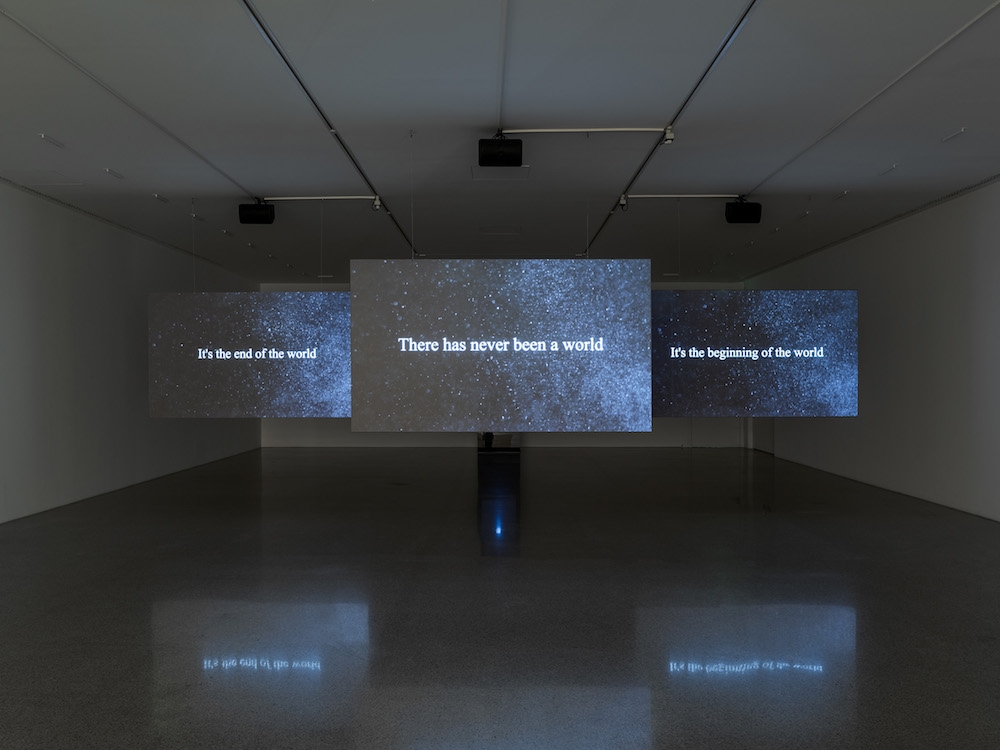Mumok, Vienna 17 March – 18 June
What is life? In Small Room, a lean show on view in Mumok’s basement, Hannah Black asks the largest of questions. The British-born, Berlin-based artist and writer recently gained notoriety after writing an open letter on Facebook calling for the destruction of Dana Schutz’s Open Casket (2016), a painting on view in this year’s Whitney Biennial depicting Emmett Till, an African-American teenager lynched in 1955. Black’s oeuvre nearly always addresses racial and gender-identity themes, alienation and how social stratifications and power imbalances inscribe themselves upon the body. Her take on the Schutz painting – that a white painter has no business rendering the physical image of a murdered young black man – created a raging social-media discussion that was ultimately parsed in The New York Times, and in many ways it encapsulates her hot-button topics.
Small Room encapsulates them as well, but far less overtly. The show’s centrepiece is a looped, ten-minute, three-channel video, Beginning, End, None (all works 2017); in its collage of manipulated and mostly moving images, Black ponders the lines demarcating life and death by considering and presenting the cell as a biological unit, but also paralleling it with prison cells (presumably the titular ‘small room’) and factories, both symbols of exploitative late-capitalist institutions. To this end, we’re presented with visual fragments: a schematic drawing, as if from a children’s book, of a human cell as, indeed, a factory; a recurring rendering of something that could be a prison; the abstracted profile of Black’s face gazing at a neon-laced landscape through a train window; and onscreen texts like, ‘There has never been a world’ and ‘It’s the beginning of the world’, sometimes read aloud, sometimes left for the viewer to read and ponder. The multitrack audio echoes the images, rapidly shifting between autobiographical snippets and grand statements addressing the macro structures that the tiny life-units must face.
Opposite the three screens, four sculptures made of creamy-coloured latex hang from the ceiling like skins, crisscrossed in draped strands of black yarn. In the film, a voice claims that no form of life exists without a membrane: these sculptures appear to be abstracted manifestations of that universal biological imperative. But even here, there’s a moment of personalisation: at the base of one membrane is a floral body tattoo. Considering Black’s prior body-related work, too, one wonders whether the odoriferous latex alludes in some way to sexuality (skin? fetishwear? condoms?), and whether its light colour is significant.
Black simultaneously zooms far in and far out on what’s always been important to her – the constrictions and limitations of biology, of societies, of ideology
Perhaps the crux of the exhibition is its least conspicuous component – two copies of a slim little novel titled Life, chained to the wall near a video-viewing bench tucked into a corner (its subtitle, ‘The mechanism by which life began on Earth is unknown’, is attributed to Wikipedia). Black cowrote this science-fiction narrative with New York-based artist/musician Juliana Huxtable; in its pages each author plays the character of a risk analyst ‘returning from the dead’, somehow to accompany or prevent the apocalypse. ‘I have retired from risk, and now nothing can happen to me. I’m a single-celled organism carved out of the white bone of the world. Mind is a miracle,’ writes Huxtable. ‘You don’t have to tell me what you were by virtue of still being,’ answers Black.
In Small Room, Black simultaneously zooms far in and far out on what’s always been important to her – the constrictions and limitations of biology, of societies, of ideology, of the ‘accepted’ representations of reality. But she also tests our limits in mixing weighty dialectics of life/death, personal/universal and present/future into a visual and textual brew that’s as unsettling as it is sticky. We learn through Black’s video that defining ‘life’ is elusive; most definitions lean on description. What is life? Depends on who’s asking, and where, when and how.
From ArtReview Summer 2017
